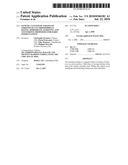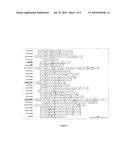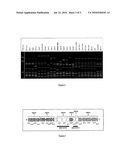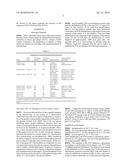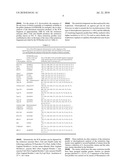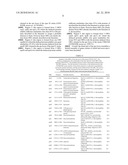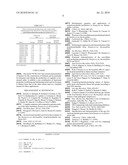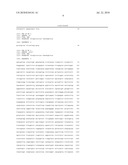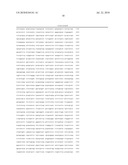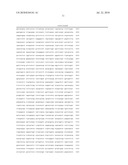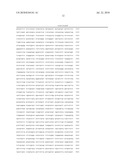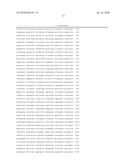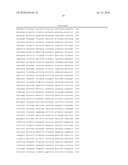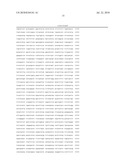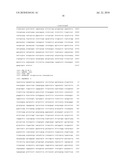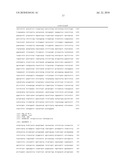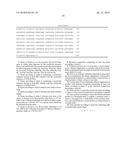Patent application title: Genetic Cluster of Strains of Streptococcus Thermophilus Having Appropriate Acidifying and Texturizing Properties for Dairy Fermentations
Inventors:
Christophe Fremaux (Poitiers, FR)
Christophe Fremaux (Poitiers, FR)
Pascal Fourcassie (Poitiers, FR)
Elise Manoury (Chatellerault, FR)
Philippe Horvath (Scorbe-Clairvaux, FR)
Assignees:
Danisco A/S
IPC8 Class: AC12P104FI
USPC Class:
435170
Class name: Chemistry: molecular biology and microbiology micro-organism, tissue cell culture or enzyme using process to synthesize a desired chemical compound or composition using bacteria
Publication date: 2010-07-22
Patent application number: 20100184181
Claims:
1. Strain of Streptococcus thermophilus the epsAD fragment of which, after
digestion by the restriction enzymes Mn/I, FokI and HindIII, has a
restriction profile characterized by DNA fragments of 344.+-.2 bp,
341.+-.2 bp, 305.+-.2 bp, 299.+-.2 bp, 277.+-.2 bp, 210.+-.2 bp, 160.+-.2
bp, 142.+-.2 bp. 100.+-.2 bp, 79.+-.2 bp, 75.+-.2 bp, 66.+-.2 bp, 42.+-.2
bp, 23.+-.2 by and 9.+-.2 bp.
2. Strain according to claim 1 comprising a nucleotide sequence having at least 80% identity with the nucleotide sequence of SEQ ID No4.
3. Strain according to claim 1 comprising a nucleotide sequence having at least 80% identity with the nucleotide sequence of SEQ ID No5.
4. Strain according to claim 1 wherein said strain is texturizing.
5. Strain according to claim 1 wherein said strain acidifies rapidly.
6. Strain according to claim 1 wherein said strain is the strain of Streptococcus thermophilus deposited on 14 Jun. 2006 at the Collection Nationale de Cultures de Microorganismes under no. CNCM I-3617 or a mutant strain which can be obtained from the latter.
7. Strain of Streptococcus thermophilus deposited on 14 Jun. 2006 at the Collection Nationale of Culture of Microorganismes under no. CNCM I-3617.
8. Bacterial composition comprising at least one strain according to claim 1.
9. Production process for a food product, a food complement, a dietary supplement or a product with probiotic properties comprising at least one stage in which the strain according to claim 1 is used.
10. Process according to claim 9 in which the food product, the food complement, the dietary supplement or the product with probiotic properties is a dairy product, a meat product, a cereal product, a drink, a foam or a powder.
11. Food product, food complement, dietary supplement or product with probiotic properties comprising at least one strain according to claim 1 or the bacterial composition according to claim 8.
12. Dairy product comprising at least the strain according to claim 1 or the bacterial composition according to claim 8.
13. Dairy product according to claim 12 wherein said dairy product is a fermented milk, a yoghurt, a matured cream, a cheese, a fromage frais, a milk drink, a dairy product retentate, a processed cheese, a cream dessert, a cottage cheese or an infant milk.
14. Dairy product according to claim 12 comprising milk of animal and/or plant origin.
Description:
[0001]The invention relates to a genetic cluster of strains of
Streptococcus thermophilus (S. thermophilus) having appropriate
acidifying and texturizing properties for dairy fermentations.
[0002]Bacteriophages are viruses capable of attacking bacteria. During se viral attacks, the bacteriophages infect the bacterial culture, and multiply in order to finally destroy this culture. The technological impact on the milk processing industry (production of cheese, yoghurt, fermented milk) of these bacteriophages is significant since they can cause a complete cessation of fermentation and therefore prevent the production of these milk-derived products.
[0003]One way of combating the problems linked to the infection of the fermentations by bacteriophages is the use of strains having appropriate sensitivity spectra to the phages. In particular, producers of dairy ferments have developed strategies to combat the bacteriophages by constructing ferments constituted by several strains having distinct lysotypes, and using several of these ferments in rotation. It is clear that in order to be able to adopt this strategy it is important to possess a diversity of strains having the same functionalities (such as for example acidification, thickening power, flavouring etc.) but distinct lysotypes.
[0004]S. thermophilus are used extensively alone or in combination with other bacteria for the production of fermented food products. They are included in particular in the formulation of the ferments used for producing yoghurts. Strains of S. thermophilus are expected to participate in the formation of lactic curd by acidification of milk and in the development of the texture of the fermented product. A distinction generally drawn between 4 groups of S. thermophilus based on these functional properties: 1) non-texturizing and non-acidifying strains, 2) the non-texturizing and acidifying strains, 3) the texturizing and non-acidifying strains, and 4) the texturizing and acidify strains. A texturizing strain is a strain making, it possible to obtain fermented milks the gels of which can be described by their rheological properties.
[0005]Hitherto only four strains of S. thermophilus corresponding criteria of acidifying and texturizing strains have been described in the literature: Sfi39, CNCM I-2423, CNCM I-2426 and the strain CNCM I-2980 described in the Application WO2004/085607.
[0006]The rarity of such strains (rapid acidification and texturizing) makes it difficult to combat the bacteriophages during the fermentation of the milk. In fact, ideally, the fight against the bacteriophages would involve the combination in the same ferment of strains having similar technological properties but distinct lysotypes, then the use of ferments of this type in rotation. The ferments used in rotation should also have distinct lysotypes but similar technological properties. In the case of the texturizing and rapidly acidifying ferments, this approach is difficult in view of the small number of strains having these functional qualities.
[0007]Thus one of the problems which the invention proposes to resolve is to provide novel strains of S. thermophilus which have a lysotype distinct from the strains currently used, in particular strains which are acidifying and texturizing.
[0008]For this purpose, the invention relates to the strains of S. thermophilus in a genetic cluster which have a lysotype distinct from that of the acidifying and texturizing strains of S. thermophilus currently used. Within this cluster novel acidifying and texturizing strains have been identified.
[0009]The invention also describes a method making it possible to predict a strain's membership of a family of strains having identical or related lysotypes. This method analyzes the restriction polymorphism of the epsA-B-C-D region of the genome of S. thermophilus.
[0010]By the epsA-B-C-D region is meant the region of the chromosome of S. thermophilus overlapping the cpsA to epsD genes of the cps locus. The DNA fragment corresponding to this region, called the cpsAD fragment, can be obtained by PCR reaction on the chromosomic DNA or S. thermophilus oligonucleotides of SEQ ID No1 and SEQ ID No2 as primers.
[0011]A subject of the present invention is a strain of Streptococcus thermophilus the epsAD fragment of which, after digestion by the restriction enzymes Mn/I, FokI and HindIII, has a restriction profile characterized by DNA fragments of 344±2 base pairs (bp), 341±2 bp, 305±2 bp, 299±2 bp, 277±2 bp, 210±2 bp, 160±2 bp, 142±2 bp, 100±2 bp, 79±2 bp, 75±2 bp, 66±2 bp, 42±2 bp, 23±2 by and 9±2 bp. The restriction profile of the epsAD fragment is determined by standard sequencing of the epsAD fragment followed by in silico determination of the restriction profile.
[0012]Typically the sequencing can be carried out with the CEQ8000 equipment (Beckman) and the in silico determination of the restriction profile can be carried out starting from the sequence of the epsAD fragment using the NEBcutter V2.0 tool accessible on the internet via the website http://tools.neb.com/.
[0013]Typically a strain according to the invention comprises a nucleotide sequence having at least 80%, preferentially at least 90%, at least 95% or at least 97% and still more preferentially 100% identity with the nucleotide sequence of SEQ ID No4.
[0014]Typically a strain according to the invention comprises a nucleotide sequence having at least 80%, preferentially at least 90%, at least 95% or at least 97% and still more preferentially 100% identity with the nucleotide sequence of SEQ ID No5.
[0015]In order to calculate the percentage identity, a person skilled in the art will example use the "BLAST 2 Sequences" tool (Tatusova & Madden, 1999; http://www.ncbi.nlm.nih.gov/BLAST/) with the default parameters of the "blastn" program (for alignment of nucleotide sequences) or of the "blastp" program (for alignment of protein sequences). The percentage similarity between two protein sequences is calculated using the BLOSUM62 matrix.
[0016]Preferentially the strain according to the invention is texturizing. Preferentially the strain according to the invention acidifies rapidly. Still more preferentially the strain according to the invention is texturizing and acidifies rapidly.
[0017]By texturizing strain of Streptococcus thermophilus is meant a strain which produces fermented milks having, under the conditions described in the example, a viscosity greater than approximately 35 Pas, a thixotropic area of less than approximately 2000 Pa/s and/or a yield point of less than approximately 14 Pa.
[0018]By rapidly acidifying strain is meant a strain which under the conditions described in the example, a Vm of less than -0.0100 upH/min.
[0019]Preferentially, a strain according to the invention is the strain of Streptococcus thermophilus deposited on 14 Jun. 2006 at the Collection Nationale de Cultures de Microorganismes under no. CNCM I-3617 or a mutant strain which can be obtained from the latter.
[0020]Typically in order to obtain such mutant strains, a person skilled in the art can use the usual mutagenesis techniques such as UV irradiation or exposure to mutagenic chemical products (ethyl-methane-sulphonate, nitrosoguanidine, nitrous acid etc.).
[0021]Preferentially, a subject of the invention is the strain of Streptococcus thermophilus deposited on 14 Jun. 2006 in the name of Danisco France SAS, 20 rue de Brunel, 75017 Paris at the Collection Nationale de Cultures de Microorganismes under no. CNCM I-3617.
[0022]A person skilled in the art, starting from the restriction profiles described previously and/or from the sequences of SEQ ID No4 and/or No5, can identify the strains which belong to the same genetic cluster the strain CNCM I-3617. Typically in order to do this, he can use PCR and/or hybridization and/or DNA sequencing techniques.
[0023]A subject of the invention is also a bacterial composition comprising at least one strain according to the invention. By bacterial composition is meant a mixture of different strains, in particular a ferment, or a leaven.
[0024]The mixtures of preferred strains according to the invention are mixtures of Streptococcus thermophilus with other Streptococcus thermophilus, or mixtures of Streptococcus thermophilus with Lactobacillus delbrueckii subsp. bulgaricus, or mixtures of Streptococcus thermophilus with other Lactobacillus and/or with Bifidobacterium, or mixtures of Streptococcus thermophilus with Lactococcus, or mixtures of Streptococcus thermophilus with other strains of lactic bacteria and/or yeasts.
[0025]A subject of the invention is also a manufacturing process for a food product, a food complement, a dietary supplement or a product with probiotic properties, comprising a stage in which a strain according to the invention is used.
[0026]Typically the food product, the food complement, the dietary supplement or the product with probiotic properties is a dairy product, a meat product, a cereal product, a drink, a foam or a powder.
[0027]Preferentially the food product, the food complement, the dietary supplement or the product with probiotic properties is a dairy product. It is for example a fermented milk, a yoghurt, a matured cream, a cheese, a fromage frais, a milk drink, a dairy product retentate, a processed cheese, a cream dessert, a cottage cheese or an infant milk. Typically the dairy product comprises milk of animal and/or plant origin.
[0028]A subject of the invention is also a food product, a food complement, a dietary supplement or a product with probiotic properties comprising at least one strain according to the invention or the bacterial composition described previously.
[0029]The invention also describes a method for predicting the lysotype of a strain of S. thermophilus starting from analysis of the restriction polymorphism of the epsA-B-C-D region of its genome, comprising the following stages:
a) amplification of the epsAD fragment by PCR reaction on the chromosomic DNA of S. thermophilus using the oligonucleotides of SEQ ID No1 and SEQ ID No2 as primers;b) sequencing of the epsAD fragment;c) in silico determination of the restriction profile of the epsAD fragment after digestion by the restriction enzymes Mn/I, FokI and HindIII; andd) comparison of the restriction profile obtained in Stage c) with the restriction profiles of the epsAD region of strains of S. thermophilus the lysotype which is known.
[0030]Examples of strains of Streptococcus thermophilus the lysotype of which is known are listed in Table 3.
[0031]The present invention is better illustrated below using the examples which follow. These examples are given only by way of illustration of the subject-matter of the invention, of which they in no way constitute a limitation.
BRIEF DESCRIPTIONS OF THE FIGURES
[0032]FIG. 1: Diagrammatic representation of the eps locus of various Streptococcus thermophilus having similarities in organization and sequence of the 5' region including the epsA, epsB, epsC and epsD genes. The GENBANK access numbers of the nucleotide sequences are given in parentheses.
[0033]FIG. 2: Alignment of partial sequences of the epsA (A) and epsD (B) genes at the level of the regions targeted by the primers of SEQ ID No1 (in the epsA gene) and SEQ ID No2 (in the epsD gene).
[0034]FIG. 3: In silico determination of the profiles obtained according to the epsAD method of the various strains of S. thermophilus the sequence of the eps locus of which is described in the literature. The images of the restriction profiles were generated using the NEBcutter tool (http://tools.neb.com/) with the following parameters: Gel Type=2% agarose; Marker=100 by DNA Ladder; DNA Type=Unmethylated; L=102 mm. The GENBANK access numbers of these strains are: AF448502 (MTC310), AF373595 (Sfi39), AF41075 (Type 1), AJ289861 (IP6757), AF454496 (Type V), Y17900 (NCFB 2393), AJ272341 (FI9186), AF454497 (Type VI), NZ AAGS01000017 (LMD-9), AF454501 (Type XI), AF454498 (Type VII), AF454495 (Type IV), AF454500 (Type X), AF454499 (Type IX), AY057915 (Type III), CP000023 (LMG 18311), CP000024 (CNRZ 1066), AF434993 (MTC360), AF430847 (MTC330), AY061649 (MR-2C), U40830 (Sfi6), Z98171 (CNRZ 368), AF448249 (MR-1C). The eps sequence of the strain CNCM I-2980 is described in the Application WO2004/085607.
[0035]FIG. 4: Diagrammatic representation of the organization of the eps locus of the strain CNCM I-3617, corresponding to the sequence SEQ ID No3. The open reading frames (ORF) represented by vertical hatching (region 1) have significant similarities with the epsA-epsB-epsC-epsD genes situated at the start of the eps locus in the great majority of the strains of S. thermophilus. The ORFs represented by horizontal hatching (region 2) have significant similarities with the eps11E, eps11F, eps11G; and eps11H genes of the type XI strain. The ORFs represented by a chequered pattern (region 4) have significant similarities with the eps4F gene of the type IV strain. The grey rectangle between regions 2 and 3 represents a non-coding region having sequence homologies with a region of the eps locus of the type IV strain. The ORFs represented by diagonal hatching (region 6) have significant similarities with the epsP, epsQ, epsS, epsR and epsT genes of the CNRZ368 strain. The unshaded ORFs (regions 3 and 5) have no significant similarities with the eps genes described for other S. thermophilus. The two black bands at the bottom of the figure represent the position of the sequences SEQ ID No4 and SEQ ID No5.
EXAMPLES
Biological Material
[0036]Table 1 and Table 3 show some of the strains used for the study. Some of these strains are obtained from the Danisco collection of strains and phages (DGCC: Danisco Global Culture Collection). The preparation of cultures of these strains was carried out according to the standard methods of microbiology.
TABLE-US-00001 TABLE 1 Description of some of the strains used for the study Other Texturizing Acidifying Bibliographical Strain name propertya propertya Related strainsb referencesc CNCM I-3617 Yes Yes Unknown None CNCM I-2980 Yes Yes DGCC2056 WO2004/085607 DGCC8013, DGCC8015 CNCM I-2423 MTC310 Yes Yes Sfi39, SY102 Lemoine et al. (1997); FI9186, Type I Germond et al. (2001); DGCC945 Marshall et al. (2001) CNCM I-2978 MTC360 Yes No Sfi6, CNCM I- Lemoine et al. (1997); 733, CNCM I- Doco et al. (1990); 734, CNCM I- Marshall et al. (2001); 735, IMDO1, 2, Stingele et al. (1996) 3, NCFB859, EU21, MR-2C, DGCC7773 CNCM I-2423 Type IV Yes No Unknown Rallu et al. (2002) CNCM I-2429 Type VII Yes No Unknown Rallu et al. (2002) CNCM I-2979 Yes No CNRZ368 MR- Bourgoin et al. (1999); 1C Low et al. (1998) DGCC7966 Yes No Unknown None DGCC7919 No Yes Unknown None DGCC7766 No No Unknown None aon the basis of industrial use and the present study. bon the basis of published sequence results of the eps locus and/or the structure of the polysaccharide and data internal to Danisco. con the strain studied and/or on related strains.
The Strain CNC 617 Belongs to a Novel Genetic Cluster
[0037]The recent determination of the complete sequence of the chromosome of two strains of S. thermophilus CNRZ1066 and LMG18311 shows a high level of conservation of the genetic content and the organization of the genes in this species) Bolotin et al., 2004). One of the rare regions exhibiting major genetic differences between these two strains corresponds to the cps locus which codes for the genes involved in the biosynthesis of exopolysaccharides. Moreover, a great diversity has already been described at the level of this genetic locus (cf. FIG. 1) since several cps sequences had been determined for various strains of S. thermophilus (for a journal article, see Broadbent et al., 2003). Flanked by the deoD (coding for a purine-nucleoside phosphorylase) and pgm (coding for a phospho-glucomutase) genes, all the clusters of cps genes in S. thermophilus are composed of a conserved proximal region (from the epsA gene to the epsD gene) and of a highly variable distal region. In spite of a conserved organization of the epsA-B-C-D genes, a significant sequence polymorphism exists in this region. The polymorphism of this region has been used to develop a tool for genetic typing of the strains of S. thermophilus: the epsAD method.
[0038]epsAD method: The tool developed is based on the specific amplification (PCR) of the epsA-B-C-D region followed by the analysis of its restriction polymorphism (RFLP). For this purpose primers have been determined which allow the PCR amplification of this region for the great majority of the strains of S. thermophilus. They have been determined by the alignment of the sequences of the epsAD region (cf. FIG. 2) and allow the amplification of a DNA fragment of approximately 2480 base pairs (bp). The genomic DNA of S. thermophilus is purified using the "DNeasy Tissue Kit" (Qiagen), then the epsAD region is amplified by PCR according to the following parameters:
[0039]Composition of the reaction mixture (50 μL): buffer for the DNA polymerase ×1, MgCl2 2 mM, dNTP 200 μM each, genomic DNA 100 to 500 ng, primer EPSA632 (5'-AAATgAATTCAgAgCAAgCACTTg-3' (SEQ ID No1)) 200 nM, primer EPSD1064 (5'-gTCATgTCAACTTTATTAAggACg-3' (SEQ ID No2)) 200 nM, DNA polymerase 1.25 units, H2O qsf 50 μL.
Amplification Parameters:
[0040]predenaturation at 94° C. for 1 min
[0041]35 cycles alternating denaturation at 94° C. for 30 s, hybridization at 56° C. for 30 s, elongation at 72° C. for 3 min
[0042]post-elongation at 72° C. for 6 min.
After amplification, the PCR product is checked by electrophoresis on 1.5% agarose gel. The size of the amplified product is approximately 2480 bp.
[0043]The sequence of the PCR fragment is determined (according to a method derived from Sanger et al., 1977) with CEQ8000 equipment (Beckman). The sequence is processed by the NEBcutter tool (for example, http://tools.neb.com/) by selecting the restriction enzymes Mn/I, FokI and HindIII in order to establish its restriction profile in silico, and in particular in order to define the size of the restriction fragments.
[0044]For the strains of S. thermophilus the sequence of the eps locus of which is partially or completely available in the public databases (GENBANK for example), the in silico analysis of the theoretical restriction products of the PCR fragment of approximately 2480 by with the restriction enzymes Mn/I, FokI and HindIII produces the restriction profiles shown in FIG. 3. These restriction profiles were established in silico on the basis of the sizes of the restriction fragments provided by the NEBcutter tool (cf. Table 2).
TABLE-US-00002 TABLE 2 Size of the DNA fragments determined by in silico digestion of the epsAD fragment by the restriction enzymes MnlI, FokI and HindIII, for the strains of S. thermophilus the sequence of the epsA-B-C-D genes of which is available. GENBANK access number of the eps Size of the MnlI, FokI and HindIII digestion fragments Strain of locus, or other of the epsAD region (size in base pairs determined by S. thermophilus reference NEBcutter, http://tools.neb.com/) MTC310 AF448502 778; 371; 344; 299; 175; 142; 100; 79; 75; 42; 35; 23; 9 Sfi39 AF373595 778; 371; 344; 299; 175; 142; 100; 79; 75; 42; 35; 23; 9 Type I AF410175 778; 371; 344; 299; 175; 142; 100; 79; 75; 42; 35; 23; 9 IP6757 AJ289861 778; 371; 299; 247; 239; 175; 100; 76; 75; 42; 35; 23; 9; 3 Type V AF454496 1264; 374; 305; 210; 123; 76; 66; 42; 9; 3 NCFB2393 Y17900 1264; 374; 305; 210; 123; 76; 66; 42; 9; 3 FI9186 AJ272341 1264; 374; 305; 210; 123; 76; 66; 42; 9; 3 Type VI AF454497 1286; 305; 277; 210; 100; 76; 75; 66; 42; 23; 9; 3 LMD-9 NZ_AAGS01000017 848; 655; 371; 175; 111; 100; 75; 60; 42; 23; 9; 3 Type XI AF454501 851; 356; 305; 299; 175; 111; 100; 75; 60; 46; 42; 23; 20; 9; 3 CNCM I-3617 SEQ ID No3 344; 341; 305; 299; 277; 210; 160; 142; 100; 79; 75; 66; 42; 23; 9 Type VII AF454498 486; 341; 305; 299; 277; 210; 160; 100; 76; 75; 66; 42; 23; 9; 3 Type IV AF454495 618; 551; 305; 299; 210; 100; 95; 79; 75; 46; 42; 23; 20; 9 Type X AF454500 571; 356; 305; 299; 277; 210; 100; 79; 75; 66; 60; 42; 23; 9 Type IX AF454499 987; 305; 299; 277; 210; 100; 79; 75; 66; 42; 23; 9 Type III AY057915 341; 305; 299; 277; 247; 239; 210; 160; 100; 76; 75; 66; 42; 23; 9; 3 CNCM I-2980 WO2004/085607 778; 374; 305; 247; 239; 210; 123; 76; 66; 42; 9; 3 LMG18311 CP000023 778; 371; 299; 247; 239; 210; 100; 76; 75; 42; 23; 9; 3 CNRZ1066 CP000024 778; 371; 299; 247; 239; 175; 100; 76; 75; 42; 35; 23; 9; 3 MTC360 AF434993 778; 371; 299; 247; 239; 175; 100; 76; 75; 42; 35; 23; 9; 3 MTC330 AF430847 778; 371; 299; 247; 239; 175; 100; 76; 75; 42; 35; 23; 9; 3 MR-2C AY061649 778; 371; 299; 247; 239; 175; 100; 76; 75; 42; 35; 23; 9; 3 Sfi6 U40830 778; 371; 299; 247; 239; 175; 100; 76; 75; 42; 35; 23; 9; 3 CNRZ368 Z98171 691; 371; 312; 305; 239; 112; 100; 76; 75; 63; 42; 35; 23; 22; 9; 3 MR-1C AF448249 691; 371; 312; 305; 239; 112; 100; 76; 75; 63; 42; 35; 23; 22; 9; 3
[0045]Alternatively, the PCR product can be digested by the restriction enzymes Mn/I, FokI and HindIII under the following conditions: PCR product 15 to 30 μL, buffer 2 (New England Biolabs)×1, bovine serum albumin (New England Biolabs)×1, enzyme Mn/I (New England Biolabs) 1 unit, enzyme FokI (New England Biolabs) 1 unit, enzyme HindIII (New England Biolabs) 1 unit, H2O qsf 50 μL. Incubation at 37° C. for 1 hour.
[0046]The restriction fragments are then analyzed by electrophoresis. Electrophoresis on agarose gel can be used. However, in order to remedy the low resolution power of this type of electrophoresis (precision +/-10%) and the difficulty of visualizing fragments smaller than 100 bp, methods with a higher resolution (+/-0.1 to 1%) such as micro-fluidic electrophoresis (Agilent) or capillary electrophoresis may be preferred.
[0047]These methods (in silico analysis of the restriction profile or electrophoresis analysis of the restriction fragments) were applied to several hundreds of strains from the Danisco collection of S. thermophilus strains and the reference strains described in the literature.
[0048]The strains which have the same restriction profile have been grouped together genetic clusters (or genetic groups) denoted CL-1 to CL-12. Comparison of the restriction profiles was carried out by means of Bionumerics software version 3.5. Table 3 summarizes some of the results obtained.
TABLE-US-00003 TABLEAU 3 Summary of the results of genotyping and lysotyping Strain Genotype Lysotype Owner Texturizing CNCM I-3617 CL-1 Resistant Danisco YES CNCM I-2423 CL-2 LT-2 Danisco YES CNCM I-2426 Danisco YES CNCM I-2424 Danisco YES Sfi39 Private YES collection DGCC945 Danisco YES CNCM I-2432 CL-3 LT-4 Danisco YES CNCM I-2978 CL-4 Danisco YES DGCC7773 Danisco YES CNRZ1066 Public YES collection DGCC7785 Danisco YES DGCC7788 Danisco YES DGCC7966 Danisco YES DGCC47 Danisco YES CNCM I-2980 CL-5 LT-5 Danisco YES DGCC2056 Danisco YES DGCC8013 Danisco YES DGCC8015 Danisco YES DGCC7790 CL-6 LT-6 Danisco YES DGCC7813 Danisco YES CNCM I-2979 Danisco YES CNRZ368 Public YES collection MR-1C University YES CNCM I-2429 CL-7 LT-7 Danisco YES ATCC BAA-491 CL-8 LT-8 Public NO collection DGCC7689 Danisco NO DGCC1086 Danisco NO SMQ-301 CL-9 University NO DGCC7853 Danisco NO DGCC7919 CL-10 LT-10 Danisco NO DGCC7766 CL-11 LT-11 Danisco NO DGCC7809 CL-12 LT-12 Danisco NO
[0049]Method for determining the sensitivity of a strain to a bacteriophage: The sensitivity of a strain to a bacteriophage is established by the lysis plaque method. 100 μl of a culture of the strain to be tested and 100 μl of an appropriate dilution of a serum containing the bacteriophage to be studied are used in order to seed 5 ml of an agar medium under suffusion (0.6% agar weight/volume) M17+glucose supplemented at 10 mM with CaCl2. The mixture is poured onto the surface of a solidified attar medium (1.5% agar weight/volume) M17+glucose supplemented at 10 mM with CaCl2. After incubation overnight at 42° C., the strain's sensitivity to the bacteriophage is evaluated by the presence of lysis plaques. The absence of lysis plaque signifies this strain's resistance to the bacteriophages tested. The spectrum of a strain's sensitivity to the bacteriophages, also called lysotype, is constituted by all of the sensitivities and resistances to the bacteriophages studied. A reference system with approximately sixty phages has been implemented in order to establish the lysotype of the strains of S. thermophilus in the Danisco collection. The strains which have the same lysotype have been grouped together in different groups denoted LT-n.
[0050]Some of the results are given in Table 3. It demonstrates in particular that the strains of the same genetic cluster virtually always have the same lysotype. The strain CNCM I-3617 belongs to a novel genetic group called CL-1 which has the very particular lysotype of being resistant to all the bacteriophages tested.
Sequence of the eps Locus
[0051]The genetic knowledge acquired with regard to S. thermophilus has shown that the eps locus is one of the major sites of heterogeneity between strains. This characteristic has already been exploited in part in order to develop the abovementioned genotyping method which uses the diversity in the epsA-B-C-D region which is the proximal region of the eps locus. An even greater diversity appears in the distal region of the eps locus (region encoding the glycosyl-transferases, see FIG. 1). This region gives the specificity of the exopolysaccharide and therefore induces at least in part the specificity of the strain's thickening power. This is therefore a region of the chromosome particularly indicated for unambiguously describing the strain CNCM I-3617 and the strains which are related to it. The nucleotide sequence of the eps locus of the strain CNCM I-3617 (starting from the epsA gene was obtained from a synthetic DNA fragment. This fragment was synthesized by PCR on a purified genomic DNA matrix of the strain CNCM I-3617 using two specific primers of conserved genes (deoD encoding a purine-nucleotide phosphorylase, and orf14.9 of unknown function) generally framing the eps locus in the S. thermophilus described in the literature. The sequence of 16037 bp originating from the strain CNCM I-3617 corresponds to the SEQ ID No3.
[0052]The sequences SEQ ID No4 and SEQ ID No5 (cf. FIG. 4) correspond respectively to the positions 6592 to 9391 and 10331 to 11373 of SEQ ID No3.
Genetic Organization of the eps Locus
[0053]FIG. 4 shows diagrammatically the genetic structure of the eps locus of the strain CNCM I-3617 established by analysis of its nucleotide sequence. The part upstream of the epsA open reading frame (ORF), the sequence of the start of the epsA ORF, and the part downstream of the epsT ORF are not known. Analysis of the sequence identifies 20 ORFs which are all oriented in the same direction. Due to their similarity of sequence with other known genes, and/or by the presence of specific protein units within products deduced from these ORFs, it is possible to attribute a putative function to them.
[0054]The structural analysis of the eps locus of the strain CNCM I-3617 shows that it possesses an overall organization similar to that of the eps loci already known (cf. FIG. 1).
[0055]The results of sequence comparison between the potential proteins deduced from the ORFs of the eps locus of CNCM I-3617 and those available in the public of databases (GENBANK) are summarized in Table 4. The eps locus of the strain CNCM I-3617 codes for proteins potentially involved in the synthesis of polysaccharide such as for example glycosyltransferases.
[0056]On the basis of these data, 6 regions can be distinguished (region 1 to region 6, from the 5' end to the 3' end of the eps locus; see FIG. 4): [0057]Region 1: this region is formed from 4 ORFs (epsA, epsB, epsC, epsD) for which the deduced proteins exhibit very great similarities (between 95.7 and 99.6%) with the proteins deduced from ORFs situated in the eps locus of strains of S. thermophilus. [0058]Region 2: this region is formed from 5 ORFs (epsE, epsF, epsG, epsG' and cpsH) for which the deduced proteins exhibit very great similarities (between 96.6 and 99.3% proteins deduced from ORFs situated in the eps locus of the type XI strain (GENBANK access no. A17454501). [0059]Region 3: this region is formed from 3 ORFS (cpsJ, epsK and epsL) for which the deduced proteins exhibit sufficient similarities (less than 81%) with proteins described in the literature to assign a probable function to them. However these ORFs are clearly distinct from ORFs already described in the literature. [0060]Region 4: this region is formed from one ORF (epsM) for which the deduced protein exhibits very great similarities (95.4%) with the protein deduced from the eps4F ORF situated in the cps locus of the type IV strain. [0061]Region 5: this region is formed from 2 ORFs (epsN and epsO) for which the deduced proteins exhibit sufficient similarities (less than 91%) with proteins of lactobacillae described in the literature to assign a probable function to them. However these ORFs are clearly distinct from ORFs already described in the literature in S. thermophilus. [0062]Region 6: this region is formed from 5 ORFs (epsP, epsO, epsS, epsR and epsT) for which the deduced proteins exhibit very great similarities (between 98.9 and 100%) with the proteins deduced from ORFs situated in the eps locus of the strain CNRZ368 (GENBANK access no. Z98171).
[0063]Overall, the distal part of the eps locus resembles a hybrid assembly of genes certain of which had never previously been described.
TABLE-US-00004 TABLE 4 Analysis of the ORFs of the eps locus of the strain CNCM I-3617. The position corresponds to the nucleotides at the start and end of the ORF in the sequence SEQ ID No3. The probable function is that of the proteins deduced from the ORF sequence. The best similarity is the protein or the deduced protein (the GENBANK access number of the protein sequence is indicated in parentheses) having the greatest similarity with the protein deduced from the ORF. The score is the percentage similarity obtained for the best similarity using the "blastp" tool (Protein-protein BLAST, http://www.ncbi.nlm.nih.gov/BLAST/). ORF Position Probable function Best Similarity Score epsA 1 to 491 Transcriptional Regulator Eps10A (AAN63761), S. thermophilus 99.4 Type X epsB 492 to 1223 Polymerization and/or Eps5B (AAN63698), S. thermophilus 99.6 export of polysaccharides Type V epsC 1232 to 1924 Polymerization and/or Eps1C (AAN63508), S. thermophilus 97.0 export of polysaccharides Type I epsD 1934 to 2674 Polymerization and/or Eps5D (AAN63700), S. thermophilus 99.2 export of polysaccharides Type V epsE 2731 to 4098 Undecaprenyl-phosphate Eps11E (AAN63787), S. thermophilus 98.9 glycosyl-1-phosphate Type XI transferase epsF 4131 to 4574 Rhamnosyltransferase Eps11F (AAN63788), S. thermophilus 99.3 Type XI epsG 4546 to 5073 Epimerase Eps11G (AAN63789), S. thermophilus 96.6 Type XI epsG' 5089 to 5553 Epimerase Eps11G (AAN63789), S. thermophilus 96.8 Type XI epsH 5644 to 5940 UDP-glucose 6- Eps11H (AAN63790), S. thermophilus 98.9 dehydrogenase Type XI epsJ 6661 to 7812 UDP-galactopyranose Glf (ZP_00045853), Lactobacillus 81.1 mutase gasseri ATCC 33323 epsK 7814 to 8896 Glycosyltransferase EpsF (AAG44710), Lactobacillus 64.9 delbrueckii subsp. bulgaricus Lfi5 epsL 8896 to 9441 Glycosyltransferase CpsI (CAC81257), S. thermophilus 65.7 FI9186 epsM 8896 to 9441 Glycosyltransferase Eps4F (AAN63682), S. thermophilus 95.4 Type IV epsN 9540 to 10370 dTDP-4-dehydrohamnose RfbD (YP_619620), Lactobacillus 81.4 reductase delbrueckii subsp. bulgaricus ATCC 11842 epsO 10955 to 11563 dTDP-4-dehydrorhamnose RfbC (NP_964906), Lactobacillus 90.6 3,5-epimerase johnsonii NCC 533 epsP 11580 to 12422 Glycosyltransferase EpsP (CAB52238), S. thermophilus 99.3 CNRZ368 epsQ 12519 to 13358 Glycosyltransferase EpsQ (CAB52237), S. thermophilus 98.9 CNRZ368 epsS 13355 to 14641 unknown EpsS (CAB52236), S. thermophilus 99.5 CNRZ368 epsR 14648 to 15790 Glycosyltransferase EpsR (CAB52235), S. thermophilus 100 CNRZ368 epsT 15790 to 16037 unknown EpsT (CAB52234), S. thermophilus 100 CNRZ368
Acidifying Property
[0064]The fermentation support is obtained by supplementing 100 ml of semi-skimmed UHT milk (Le Petit Vendeen®) with 3% (weight/volume) of skimmed milk powder (SUP'R TOP®, Eurial Poitouraine). The sterility of the solution is obtained by pasteurization for 10 min at 90° C. (at the core). The fermentation support thus obtained is inoculated with the strain to be tested at a rate of 106 cfu/ml, then incubated at 43° C. (in a water bath). The pH is continuously monitored using a CINAC apparatus (Ysebaert).
[0065]The acidifying properties of the strains of S. thermophilus can be described by the maximum rate of acidification, Vm (pH unit/min (pHu/min)), calculated by the maximum value of the first derivative of the pH curve as a function of time. Under these operating conditions, it is estimated that this variable is characteristic of the strain. Its value is constant whatever the physiological state of the micro-upon inoculation of the milk and the level of seeding. Two groups of strains are distinguished, the strains with so-called slow acidification, the Vm of which is greater than -0.0100 pHu/min, and the strains with so-called rapid acidification the Vm of which is less than -0.0100 pHu/min. The strain CNCM I-3617 clearly belongs to the group of the so-called rapid acidification strains (Table 5). This property is very often linked to the presence in the genome of the strains of a gene encoding the wall protease PrtS which could be detected in the genome of CNCM I-3617.
TABLE-US-00005 TABLE 5 Maximum rate of acidification of different strains of Streptococcus thermophilus evaluated under the operating conditions described. Maximum rate (×-1.E5 upH/min) Standard Strain Average deviation prtS gene CNCM I-2429 66 24 absent DGCC7966 68 12 absent CNCM I-2432 80 13 absent DGCC7766 82 13 absent CNCM I-2978 88 12 absent DGCC7773 92 17 absent CNCM I-2979 102 33 absent CNCM I-2423 129 24 present CNCM I-3617 144 7 present CNCM I-2980 167 27 present DGCC7919 190 22 present
Texturizing Property
[0066]The fermentation support obtained by supplementing 100 ml of semi-skimmed UHT milk (Le Petit Vendeen®) with 3% (weight/volume) of skimmed milk powder (SUP'R TOP®, Eurial Poitouraine). The sterility of the solution is obtained by pasteurization for 10 min at 90° C. (at the core). The fermentation support thus obtained is inoculated with the strain to be tested at a rate of 106 cfu/ml, then incubated at 43° C. (in a water bath) until a pH of 4.6 is obtained. The pH is continuously monitored using a CINAC apparatus (Ysebaert). The fermented milks thus obtained are placed in a ventilated oven at 6° C., until they are analyzed. Two types of rheological measurements are carried out: viscosity and flow. The viscosity measurements are carried out at a temperature of 2° C. on fermented milks after storage for 1, 7, 14 and 28 days at 6° C. The equipment used is a RVF-type Brookfield® viscosimeter (Brookfield Engineering Laboratories, Inc.) mounted on a Helipath stand Brookfield Engineering Laboratories, Inc.). The viscosimeter is equipped with a type C needle and the oscillation speed applied to the needle is 10 rpm. The flow measurements are carried out at a temperature of 8° C. on previously-stirred fermented milks, after storage for 14 days at 6° C. The equipment used is an AR1000-N rheometer (TA Instrument) equipped with co-axial cylinders (Radius 1=15 mm, Radius 2=13.83 mm, Height=32 mm, Air gap=2 mm). For the ascending segment, the stress applied in a continuous sweep varies from 0 to 60 Pa for a duration of 1 min according to a linear mode. For the descending segment, the stress applied in a continuous sweep varies from 60 to 0 Pa for a duration of 1 min according to a linear mode. The values taken into account are the thixotropic area and the yield point; the latter is calculated according to the Casson model.
[0067]The texturizing ability of a strain can be evaluated in a first phase by a viscosity measurement of the curd obtained under the operating conditions described above. The recognized non-texturizing strains provide viscosity values close to 30 Pas while the texturizing strains exceed 40 Pas. This texturizing ability can be more or less pronounced (Table 6). For example the strain CNCM I-2979 produces a curd the viscosity of which reaches 42 Pas, and the strain DGCC7966 makes it possible to obtain a clearly higher viscosity, of 70 Pas. The strain CNCM I-3611 provides curds the viscosity of which amounts to 54 Pas (Table 6). This value places this strain among the group of strains with a texturizing ability fully comparable to the industrial strains currently used to devise lactic ferments for the production of yoghurts and fermented milks.
TABLE-US-00006 TABLE 6 Viscosity of the fermented milks obtained with the different strains tested, after storage at 6° C. for 14 days. Viscosity in Pa s Standard Strain Average deviation DGCC7966 70.0 Nd DGCC7773 55.0 3.3 CNCM I-3617 54.0 2.5 CNCM I-2980 53.0 2.9 CNCM I-2429 51.0 3.1 CNCM I-2978 49.6 4.2 CNCM I-2432 43.0 4.0 CNCM I-2979 42.2 3.0 CNCM I-2423 42.0 4.6 DGCC7919 28.0 Nd DGCC7766 30.0 Nd Nd: not determined
[0068]The rheological analyses using the AR1000-N rheometer made it possible to measure two rheological descriptors relevant for qualifying fermented milks: the yield point of the product (Pa) and the thixotropic area (Pa/s). These measurements are reported in Table 7 for each of the strains. For the fermented milk with the strain CNCM I-3617, the average values are 11.25 Pa and 352 Pa/s respectively. These values are significantly different from those measured on curds obtained with strains deemed non-texturizing (DGCC7766 or DGCC7919).
TABLE-US-00007 TABLEAU 7 Values of yield point and thixotropic area, Casson model, measurements by the AR1000-N on fermented dairy products with different strains after storage for 14 days at 6° C. Yield point Thixotropic (Pa) area (Pa/s) Standard Standard Strain Average deviation Average deviation CNCM I-2980 5.89 0.9 488 107 CNCM I-2423 8.86 0.9 1344 574 CNCM I-2978 10.51 0.4 728 153 CNCM I-3617 11.25 0.4 352 53 CNCM I-2432 12.27 1.3 1245 181 CNCM I-2429 13.32 1.2 1215 255 CNCM I-2979 13.56 Nd 1786 250 DGCC7773 14.00 Nd 60 Nd DGCC7966 15.00 Nd 43 Nd DGCC7919 15.91 0.2 33100 1415 DGCC7766 17.01 0.1 17083 1520 Nd: not determined
CONCLUSION
[0069]The strain CNCM I-3617 has several characteristics of interest for the construction of ferments and in particular for ferments used during the production of yoghurts or fermented milks. It exhibits a rare combination of functional properties (acidifying and thickening strain) and its lysotype is distinct from that of the other strains used in a standard manner for these applications.
BIBLIOGRAPHICAL REFERENCES
[0070]Rolotin A, Quinquis B, Renault P, Sorokin A, Ehrlich S D, Kulakauskas S, Lapidus A, Goltsman E, Mazur M, Pusch G D, Fonstein M, Overbeek R, Kyprides N, Purnellc B, Prozzi D, Ngui K, Masuy D, Haney F, Burteau S. Boutry M. Delcour J, Goffeau A, Hols P (2004). [0071]Complete sequence and comparative genome analysis of the dairy bacterium Streptococcus thermophilus. [0072]Nat Biotechnol. 22(12), 1554-1558. [0073]Bourgoin F, Pluvinet A, Gintz B, Decaris B, Guedon G (1999). [0074]Are horizontal transfers involved in the evolution of the Streptococcus thermophilus exopolysaccharide synthesis loci? [0075]Gene. 233(1-2) 151-161 [0076]Broadbent J R, McMahon D J, Welker D L, Oberg, C J, Moineau S (2003). [0077]Biochemistry, genetics, and applications of exopolysaccharide production in Streptococcus thermophilus: a review. [0078]J Dairy Sci. 86(2), 407-423. [0079]Doco T, Wieruszeski J M, Fournet B, Carcano D, Ramos P, Loones A (1990). [0080]Structure of an exocellular polysaccharide produced by Streptococcus thermophilus, [0081]Carbohydr Res. 198(2), 313-321. [0082]Germond J E, Delley M, D'Amico N, Vincent S J (2001). [0083]Heterologous expression and characterization of the exopolysaccharide from Streptococcus thermophilus Sfi39. [0084]Eur Biochem. 268(19), 5149-5156. [0085]Lemoine J, Chirat F, Wieruszeski J M, Strecker G, Favre N, Neeser J R (1997). [0086]Structural characterization of the exocellular polysaccharides produced by Streptococcus thermophilus SFi39 and SFi12. [0087]Appl Environ Microbial. 63(9), 3512-3518. [0088]Low D, Ahlgren J A, Horne D, McMahon D J, Oberg C J, Broadbent 998). [0089]Role of Streptococcus thermophilus MR-1C capsular exopolysaccharide in cheese moisture retention. [0090]Appl Environ Microbial. 64(6), 2147-2151. [0091]Marshall V M, Laws A P, Gu Y, Levander F, Radstrom P, De Vuyst Degeest B, Vaningelgem F, Dunn H, Elvin M (2001). [0092]Exopolysaccharide-producing strains of thermophilic lactic acid bacteria cluster into groups according to their EPS structure. [0093]Lett App Microbiol. 32(6), 433-437. [0094]Rallu F, Taillez P, Ehrlich D, Renault P (2002). [0095]Common scheme of evolution between eps clusters of the food bacteria Streptococcus thermophilus and cps clusters of the pathogenic streptococci. [0096]Proc. 6th Am. Soc. Microbiol. Conf. on Streptococcal Genetics, Asheville, N.C. Page 112. [0097]Sanger F, Nicklen S, Coulson A R (1977). [0098]DNA sequencing with chain-terminating inhibitors. [0099]Proc Natl Acad Sci USA. 74(12), 5463-5467. [0100]Stingele F, Neeser J R, Mollet B (1996). [0101]Identification and characterization of the eps (Exopolysaccharide) gene cluster from Streptococcus thermophilus Sfi6. [0102]J Bacteriol. 178(6), 1680-1690. [0103]Tatusova T A, Madden T L (1999). [0104]BLAST 2 Sequences, a new tool for comparing protein and nucleotide sequences. [0105]FEMS Microbiol Lett. 174(2), 247-250.
Sequence CWU
1
5124DNAStreptococcus thermophilus 1aaatgaattc agagcaagca cttg
24224DNAStreptococcus thermophilus
2gtcatgtcaa ctttattaag gacg
24316037DNAStreptococcus thermophilus 3agttgattga ccaacttggt ggtgtgacag
tccataatga tcaagctttc acaagtcttc 60atgggaagtt tgatttccca gttggagata
tccaaatgaa ttcagagcaa gcacttggat 120ttgttcgtga acgctatagt ttagatgacg
gagataatga ccgtggtaaa aaccaggaga 180aagtcatttc tgcgattgta aacaagttgg
cttctctaaa gtctgtatca aactttactt 240caatcgttaa taatctccaa gactctgttc
agacaaatat ttctttggat accattaatg 300ctttggctaa tacacaactt gattcaggct
ctaaatttac agtaacgtct caagcagtaa 360ctggtacagg ttcaaccgga caattgacct
cttatgctat gccaaattct agtctttaca 420tgatgaaact agataattcg agtgtggcaa
gagcctctca agctatcaaa aatctgatgg 480aggaaaaata agtgattgac gttcactcac
atattgtttt tgatgttgat gatggtccta 540aaactttaga agaaagttta gacctcattg
gtgaaagtta cgcccagggg gtacgtaaga 600ttgtttcaac atcccatcgt cgtaagggaa
tgtttgagac tccagaggat aaaatttttg 660ccaacttttc taaggtaaaa gcagaagcag
aagcacttta tccagactta actatttatt 720atggaggtga actttattac accttagaca
ttgtggagaa acttgaaaag aatctcattc 780cgcgcatgca caacactcaa tttgctttga
ttgagtttag tgctcgcaca tcttggaaag 840aaattcatag tgggcttagt aatgttttga
gagcgggggt aacgcctatt gttgctcata 900ttgagcgcta tgatgccctc gaagaaaatg
ctgatcgtgt tagagaaatc atcaatatgg 960gctgctatac tcaagtcaat agctcacatg
tcctcaaacc aaagctcttt ggagataaag 1020ataaagtagg aaaaaaacgt gttcgttatt
tcttggagaa aaatttggtt catatggttg 1080ctagtgacat gcataatctt ggtccaagac
caccatttat gaaagatgct tatgaaattg 1140ttaaaaagaa ctacggctcc aaacgtgcta
agaatctttt tattgaaaat cccaaaacat 1200tactagaaaa tcaatattta taggagatat
tatgaatcaa gataacacta aaagtgatga 1260aatcgacgta ctagcattgc tacataaact
ttggacgaag aagcttttga ttcttttcac 1320agttttttat ttcgctgctt tcagtttctt
aggtacttat ttctttatcc aaccaacata 1380tacatcaaca acgcgtatct atgtggttaa
tcaggcaaca gataataaga atctttctgc 1440tgaagctttg caggccggta catttttgac
aaaagactac aaagaaatta ttacatcaaa 1500cgatgtcttg tcagaagtta tcaaagatga
aaaattgaat atgacagtag cagaacttgc 1560taaaatgatt ttagttgata atcctactga
tactcgtctt atttcaattt ctgttaatgc 1620taaaactggt caagatgcgc aaacacttgc
caataaggtt cgtgaagttg cttcagaaaa 1680aatcaagaac gtgacaaaag ttgaagatgt
tacaacgctc gaagaagcta aattgccaga 1740gtcaccatct tcaccaaata tcaaacttaa
tgtgcttctt ggggcagtgc ttggaggatt 1800ccttgcagtg gttggtgtat tggtacgtga
aatcctagat gatcgtgttc gccgtccaga 1860agatgtggaa gatgcccttg gaatgacact
tcttggaatt gtccctgata cagataaaat 1920ttaaggagaa gaaatgcctc tattaaagtt
agtaaaatct aaagtaaact ttgccaaaca 1980aacagaagag aattacaatg ccattcgcac
aaatattcaa ttttctggtg ctcagattaa 2040agtgattgcg attagctctg ttgaagctgg
tgaaggaaaa tcaacgacat ctgttaactt 2100ggcgatttca tttgctagtg ttgggctccg
aacacttctg attgatgctg atacgcgtaa 2160ttctgttttg tcgggtacat ttaaatcaaa
tgagccttat aaaggtcttt caaatttcct 2220ttcaggaaat gccgatctaa atgaaacgat
ttgccaaact gatatttctg gtttggatgt 2280tattgcatct ggtcctgttc cacctaatcc
aacaagtctt ttgcaaaatg acaattttag 2340acatttgatg gaagttgctc gtagtcgtta
tgattatgtc atcatcaata caccaccaat 2400tggtatggtt attgatgcag ttattattgc
ccatcaggct gatgccagtc ttttggttac 2460agaaggtggg aaaatcaaac gtcgtttcgt
aactaaggcc gttgaacaat tggaacaaag 2520tggttctcag ttcttagggg tcgtccttaa
taaagttgac atgacagttg ataaatatgg 2580atcatatggt tcttacggat catatggcga
gtatggaaaa aaatctaacc aaaaagaagg 2640tcattcaaga gcacatcgtc gtagaaaagg
atagcattaa tggggatgat gcggttcctt 2700ataccttaac agattaaaaa ggggtttaga
gtgaaagaaa aacaagaaat tcatcgcatt 2760gaaattggta ttatacagtt ggttgtggtt
gttttcgcag ccatggtagc tagtaaaata 2820ccttatacag agattaccca aggaagcatt
gtccttttag gtgtcgtaca tgtagtgtct 2880ttctatatca gtagttatta tgaaaatctt
aagtatagag gctacttgga tgaactcatt 2940gcaactgtca aatattgttt catatttgct
ctaattgcaa ctttcctctc gttttttgca 3000gatggaagtt tttctatctc acgtcgcgga
cttctttatg ttactctgat ttcaggtgtt 3060ctcttatacg ttacaaatac tgttcttaag
tatttccgct cttctattta tacacgtcgt 3120aaaagcaata agaatattct cttgatttct
gatcaggcac gtcttgataa tgttttgtct 3180cgtatgaaag acaatatgga tggtaggatt
acagccgttt gtgtcttgga taatccttat 3240ttcacggatc catttatcac gagtgttaaa
cctgaaaatt tgattgaata tgcgacacac 3300tcagtagtag accaagtttt gattaatctg
ccaagtgggc agtataagat ttgggattat 3360gcatcacctt ttgagatcat gggaattcca
gtttctatta atttgaatgc ccttgaattt 3420atgagtcaag gtgaaaaacg tattcaacaa
ttggggcctt tcaaagttgt tacgttttca 3480actcaatttt atagctatgg agatgtcttg
gcgaaacgtt tcctcgatat ctgtggagcc 3540ctagttggtt tggtgctctg tgggattgtt
ggaatcttcc tttatccact tattcgtaag 3600gatggtgggc cagccatttt tgctcaagac
cgtgtgggag aaaatggacg tatcttcaag 3660ttttataaat tccgttctat gtgtgttgat
gcggaagaaa tcaagaagga tttgatgaca 3720cagaatcaaa tgtctggtgg tatgtttaag
atggacaatg atccacgtat taccaaaatt 3780ggacatttca ttcgtaaaac gagtcttgat
gaacttccac aattttggaa tgttctaaaa 3840ggtgatatga gcttggtagg aacacgtcca
ccaacattgg atgagtacga atcttataca 3900ccggaacaaa aacgtcgcct cagctttaaa
ccaggtatta ctggtctttg gcaagtaagc 3960ggtcgaagtg aaattactaa ttttgatgaa
gttgtaaaac tagacgttgc ttatttggac 4020ggatggacaa tctggcgaga tatcaaaatc
ttattgaaaa cgattaaagt agtagtaatg 4080aaggatggag caaagtaatg gctttctcca
tttcttttaa tgttgattaa atgacaaaaa 4140cagtttatat cgttggttct aaggggattc
cagcaaagta tggtggtttt gagacttttg 4200tagaaaaact aacggcacat caaagtaata
aaaaccttaa gtatcatgtt gcttgtttat 4260cgaatggtat acaagaaaat tttaatcata
atgatgcaga ctgttttaat atttcaaaga 4320aaaatattgg accagcaaac gccatttatt
atgatttggc agctttaaaa tactcactta 4380aagaaattgt agaaaatagg tatgagggtg
caattattta cattttagct tgtcgtattg 4440gtccatttat tggtcactat aaaaagcaaa
tgaaaaaatt aggaattact ttgatggtaa 4500atcctgatag ggagtgtgaa ataatatggg
caaccagaca aaagcctgat ttcatgcggg 4560tttacgcggc ttgacctttt cacctcaacc
tatttctgcc tgtcatggtg tgttgcggcc 4620ggtttcatag gttctaacct tgtgaaacga
atttatcagg aggctccttc tgctacggtt 4680atcggcatcg acaacatgaa tgcctactat
gatgtggcac tgaaagagtt cagcctgaat 4740gagctggcca agtatcccac atttaccttt
atcaaaggca acatcgccga caaggagctg 4800atcacggagc tgttcgagaa gtacaagccg
tctgtggtcg tcaaccttgc tgcacaggct 4860ggtgtgcgtt acttcatcac caacccggat
gcttatgtgg aatctaacct ggtcggcttt 4920ttcaatatcc ttgaagcatg ccgccattgc
gagaagagtc tagagcatct ggtttacgcc 4980tcctcctcca gcgtttacgg ttccaataaa
aaggttccgt atagcactaa cgacaaagtg 5040gacaatcctg tctctctgta cgcagcaacc
tagaagtcta atgagctgat ggctcacgct 5100tactccaagt tgtacaacat tccgtctact
ggtctgcgct ttttcacagt gtatggtcct 5160gcaggtcgtc cggacatggc ctacttcgga
ttcaccaaca agctggtgaa gggcgaaacc 5220atcaagattt tcaactatgg aaactgcaag
cgtgatttta cttatgtgga tgacatcgtt 5280gagagtgttg tccgtgtgat gaagaaagca
ccggacaaga aaaatggtga agatggtttg 5340ccgattccgc cgtatgcagt ttacaacatt
ggtaatctga accctgagaa cctgctagat 5400ttcgtgcaga ttctgagtga ggagttagta
agagcgaaag ttctgccgga agattatgac 5460ttcgaggcac acaaggaact tgttccgatg
cagccgggtg atgtgcctgt gacctatgca 5520gataccagcg cactggagcg tgacttcgga
taaaagccga gcacaagtct gcggactgga 5580ttaagaaatt ttgctgagtg gtacgctgag
ttttataaat aaaagaatta gaggaataga 5640gaaatgagaa agtttaaaga tttaaagatt
gctgtggctg gtactggtta tgttggtctt 5700tctattgcta cgttgctgtc tcagcatcac
aaggtgacgg cagtagatat cattcctgag 5760aaagtagagc tgatcaataa caagaagtct
ccgattcagg atgagaacat tgaaaagtat 5820ctggcagaaa aggaactgga tctgaccgca
acgttggatg cgaaggaagc atacagtgat 5880tctgattttg tcgtaatcgc tgcaccgaca
atgtctactc aacaaaccat attgacgtag 5940aaacgtcgaa aagaacctgt tttgcacact
atatagggca ctgaaattgg ttatatttca 6000cagctatatg agctataaat gctagatact
tatacaaaat gctgaacttt tggcccatgt 6060ggcacaaaat tggcacatct ttttcagaag
aatcatagaa atggcggaaa acaggagaaa 6120acaacaaaaa tccatgaatt tatcattaac
gtctgaaact gctgttgagt acactatctg 6180acccgctaat gacacctaca tcataacggt
ttgttgagtc atgaaaaata gagaaaaaca 6240gatgatttct acttcaaaaa acagctgttg
agtagagcat gaatggtgat gataattaca 6300tgttttgagt ggttaaagtg aatgatttgt
tcataacgaa caatgaatgg tgagaattgg 6360actggatgat atatacagtt ttaacaaaac
tcatgtgccg acagggttcg attcaacaat 6420ccaacactta gaaaaacgtc attgcagggt
atacggggtt cgactgtata aatcaacact 6480tcggttatag aggaatagag acgagtgtac
tcaacggatg ttttatgaag tagaaacatg 6540attgcggggg taattggata cgacagtata
agaaaacact tagccgtgtg atgaacacac 6600gggagaatta gagagaaata ccatccaatg
aggatgtgta gatagatata aaaatgagga 6660atgaacccag taagagtgga ggagtacatt
atggaaaaat ttgattattt agtagtaggt 6720tctggccttt acggggcgat ttttgcacat
gaagccaaga atcatggaaa atctgtttta 6780gtagtagata agtgtcctaa cattgcggga
aatatctata ccaaaaacat tgagggtatc 6840aatgtccata aatatggagc gcatattttc
cacactaaca acaaaaaggt ctggaactac 6900attacacagt ttgctgagtt caaccgcttc
accaactccc ccgtggccaa ctacaaaggc 6960gagctgtatt cgctgccttt caacatgtat
acatttaata aaatgtgggg cgtcgtgacg 7020ccggaggaag ctgccaccaa aatcgcggag
caacgcaagg aaattactca tgagcctcag 7080aatctcgaag agcaggccat ttctcttgtc
ggccgtgata tctacgagaa acttattaag 7140ggctacactg agaagcagtg ggggcgcgat
tgtaaagagt tgccgtcctt tattattaag 7200cgtcttccgg ttcgcctgac ttttgataac
aactacttca atgcgcttta tcagggtatc 7260cctgtcggtg gttataccaa gatgattgct
aatctgctgg atggcattga ggttcgtttg 7320aatacagact atctggcgaa caaggtagag
ttggatgcat tggctgacaa ggttgtatac 7380actggaccga ttgatgctta ctttgactat
cagttgggta cattggaata ccgatctgtt 7440cgctttgaaa cggaaacatt ggacaagcct
aattttcagg gtaacgcagc agtgaattat 7500accgaccgtg aaactccgtg gactcgcatc
attgagcata aatggtttga gtttggcaag 7560gatgaaaatg gcaatgatct gccaaagact
atcatcagcc gtgagtacag cagtgagtgg 7620aagccgggag atgagccgta ttatccggtc
aacgatgcta agaatagctt gctttattct 7680gagtataaga agctggcaga tgcagaagaa
aaagtaatct tcggcggtcg tcttggcgag 7740tataagtatt atgatatgga ccaggtaatt
gcagctgtgt tggataaatg caagaaggag 7800ctgggagaat aaaatggcaa agaaaaagat
tttaatggtc tgtgaagctt ttggaggtgg 7860agtatttacc tatgtatctc aactctgcaa
cgatatggtg gatgattttg acgtttatct 7920tgcatattcc ctcagaccgc agacccctaa
gaattacaaa gattttctgg atcagagagt 7980gcatttgatt gaaatgcaaa atgtcggagt
taagggacta acaaacttaa agagtgacat 8040tgcagcaatt aaggaattgc gtcagattga
aaaagatgtt cagccagatg tgattcacct 8100gcattcttcg gttgcaggtg gtttaggtag
acttgcatat aacggaaaaa ataatactgt 8160tgtgtacaca cctcatgggt atgcacatat
tcttatgggt ccggggaaga agagaaaagt 8220ctataagttt gcagaaaagg ttctcggaaa
tcgagcactt acacttacct gttgcgaaag 8280tgaagatgaa gaagcaaaga aattctccaa
gagaacagct tatgttgaaa cgggtgtgaa 8340tcttgcagac ctttcggcat cccttgacgg
tattaagcct gtaaaaaatg ataagttcac 8400agtttttacg cttggtcgcg cctgcgttca
gaaacagcca cagcttttta atagaattgc 8460tgaactagta ccagatgcaa gatttatttg
gattggtaac ggagaacttg aaaatgagtt 8520aactgctcca aatattgaag tgacgggatg
gaaacctcgt aaggaagctt tggcaatggc 8580caaaggtgca gatgcattta ttttgtgcag
tcttggtgaa gctattgcaa tgagccttat 8640tgagaatatg tacattaaaa agctgattct
cgttagcaat acaatgggaa ataagagtgt 8700tatcaatgat ggcatcaatg gatatgtctg
tgataaggcg gaggagtatg ctgaacatat 8760aaaagcggct atgaaggagt ttcctaaaga
acttcctgaa agagcatatc aggatgtcct 8820tgagatttat aatactgatg ccatgaagaa
gaagtatatt gagttttata atgatgttgt 8880ggcaggtaaa tactgatgat aaaaaatatg
gactatttag tttccgtcat tgttcccata 8940tacaaagtgg aaaaagattt gtcggattgc
gttctgagca tttgcaatca gacctataca 9000aatttagaga ttattcttgt tgatgatggc
tctccagata attgtggaca aatgtgtgat 9060gaatttgcaa aaaatgatgt ccgaataaag
gttattcata aaattaatgg agggttatca 9120caagctcgaa atgctggaat gagcattatg
acgggagatt atattacatt tgttgatagc 9180gatgacattt tggaacatga atttattgaa
gaaatgttga ggataattaa taaatataat 9240gctcaagttg caatttgcaa aaattctaca
tttgaaaaag gcggtacact taataatggt 9300catgtaggaa taagcgaacg aagctttgat
gcggtagaag ccataaagaa catgttatat 9360caaaaggatt ttgatgttgc agcatgggga
aaaatgtaca tcaaaaaata cgaaaatgcg 9420ctgaatgaac ggggggtata gcatgactta
attcgtttta ttgcggttgt caggccgtac 9480acccttgcat actctgttag tattgagcca
gataattatg gcactgcaaa ggcggtggca 9540tgatgaaaaa gataaggatt ttacatgtag
cgcaagctgc tggcggcgtg gatcgctaca 9600tccgaatgct tctcaagcat ttggataagg
aaaaatttga gaatatactg gtttgctcac 9660aggatttcct tgaggaagat tatagaggat
tggttgattc ttttgaacga atcgaaatga 9720ccagagctat tggtggcaac gacttaaaag
caattaaaga agttagaaat ctgataaaga 9780aatataaccc tgacattgtt tatgctcact
ccagtaaggc tggagccatt gcccgtgttg 9840ccgatatcgg tttgaaaaat tactgtgtat
ataacccaca cgggtgggca tttaacatgc 9900gttgttctgc aaagaaaaaa gcaatataca
cggctattga aaagattgct gctccattct 9960gtgaaaagat tatctgcatt tcggatgcgg
agaggcagtc agcattggat aaaaaaatat 10020gcaaagaaga taagttacag gtcattttta
acggtgtgga tatcgaggcc tacgaaaatg 10080gagtacatgg cgctgttaag agagaagacc
tgaacatacc ggatgatgca tttgttgtcg 10140gcatggttgg acgaatgagc ccacagaaag
caccagatgt ttttgttaag atggcaaagc 10200aagtaaagga gaaagttttg aatgcacact
tcattattgt tggcaacgga aatcaagaag 10260ccgaaattag aaagtatgtg gaggacaatg
gtttctcgaa cagcctgcat attacaggct 10320gggttgataa aacgttgcag atgtctgcaa
gaagatggat tgcaaaatga cctacatcag 10380cacagactat gtgttcgatg gtcagggtac
cgagccttgg cagccggact gcaaggatta 10440caagcctttg aatgtgtacg gtcagacgaa
gctggaaggt gagttggcgg ttagccagac 10500gttggagagg tatttcattg tccgcattgc
atgggtattt ggtctgaatg gtaagaactt 10560catcaagacg atgctgaatg tcggcaagac
acacaatact gtccgtgtgg tcaatgatca 10620gatcggtaca ccgacctata catacgattt
ggctcgactg ctcgtcgata tgaatgagac 10680tgagaagtat ggctattacc atgcgaccaa
cgagggtggt tatatcagct ggtacgattt 10740aacgaaagaa atttatcgtc aggtgggcta
taagacagca gaggtgcgtc cggtaagtac 10800ggaagagtat gtcctgagta aagcaactcg
cccgtttaac agtcgtctgg ataagagcaa 10860gttggtagaa gctggcttta ctctgcttcc
gacctggcaa gatgcgctga gccgttacct 10920gaaagaagtt gagcagtaag aggagataga
gaagatggga cagataaaag ttgagaaaaa 10980tgtaggcggt atcgaaggac tttgcgttat
tgaacctgct gttcatggcg atgctcgtgg 11040ctatttcatg gaaacctaca acgaaaaaga
tatgaaagaa gcaggcattg acatccactt 11100cgtgcaggac aatcagtcta tgtccactaa
gggcgttctg cgcggtttgc atttccagaa 11160gcagtatccg cagtgcaagc tggtacgcgc
catgcgtggt actgtgtttg atgttgcggt 11220tgacctgaga agtgattcta agagttacgg
caagtggtat ggtgttacac tgtccgctga 11280gaacaagaag cagttcctca ttccagaggg
atttgcgcac ggtttcctgg ttctgagcga 11340tgaggcagag ttctgctata aggtcaacga
cttctggcat ccgaatgacg agggtggcat 11400ggcttggaac gacccggaga taggcattga
gtggccggaa ctgaagggcg agtataaggg 11460cagcgcaagt gctgaaggct acacgctgaa
agatggtact gcattgaact tgagcgataa 11520ggaccaaaag tggctgggac tgaaagatac
ttttaaattt taaggataag gaataatcga 11580tgaagatatg ttcaatagtg gttctatatg
agcctaataa caaagaaata gaaaatattc 11640tggattatta tgacagcgtt gataaagcat
atattttaga caactcagtt gaaagcagag 11700aagcaattgt aaatgatgtt ttatcgaagc
gtagtgggta tgtcaaagaa aaagcggagt 11760acatccattt ccataaaaac attggtttat
gcaaagcatt aaaccatgga atgaaactgg 11820cggcagatga aggctttgaa tgggctctta
ttatggatgc cgatagtacc ttcaatacta 11880atgttgtgaa agtatataaa gattatatcc
aaaagaataa ctgcagtaaa ataggtgtcc 11940ttgcgccagt acatcttcat gatagaaacc
ttgagagtaa atttgaagga caaagagatg 12000tgtcttgggc gatgacatct ggatgctttt
ataatatcag cgtgtttgaa actgctaatg 12060ggtttaaaga ggaacttttt gtagacggtt
tggatataga ttattgctat aaaatgcata 12120gatatgggta tcgcgtagta gaacttgcgg
atgcccgaat taatcatttg ccagctgaaa 12180ctcgcatgtt taatcttggt ggatttaaag
taaaatatgg tgtggcttca ccgtggcggt 12240attacatgca agctagagca atagtttggt
tggcactgga gtataagtcg ctaagggagg 12300tagctcgata ctgcgtgaaa tggggaaagg
tacttctctt gtttgataat aagacggatt 12360acataaaaca acttatgcat ggaactaaag
atgggataaa actatggaga agtattcact 12420gagtggaata gttttatgac gttttattat
gatttagaca tagttattat cagaaataga 12480taaaataccg tatcaattca atggaggata
tattacacat ggacatatca gcgggcattg 12540tccttttcaa cccagacata aaaagattaa
aagagaacat agatgctgtt attattcagt 12600gtactcattt gtatttggta gataacggat
ccggcaatgt tgatgaagta aaagggttac 12660tgaatcaata caatcaatca aagatttcta
ttctgtggaa cagggaaaat cagggaattg 12720ctaaggcatt aaatcaactt actagtgcag
cacaaaaagg gggatttgat tggattctta 12780cattggatca ggattcagtt gtcccgtcta
atatcgttgg agaatttgaa aaatatataa 12840ataattctag tgtaggaatt ctttgcccga
ttatttgcga tagaaataaa ggtgaagaaa 12900ttaaaataaa tgaagactgt acggaaatag
atgaatgcat tacatctggc tctcttttga 12960atatcaaggc atggagtgaa attggtggtt
ttgatgagag gatgtttatc gatggcgttg 13020attttgatat ttgctatcga ttaagacaaa
ggggctataa aatctactgc atccatagtg 13080tggtgttatt gcatgagatt ggacatattg
aatatcatcg tttccttttc tggaaagtac 13140ttgttatgaa ccattcggcg tttcgcaaat
attatatagc tagaaatatt atttatactg 13200ccaagaaaag aagaagtacg ctgctggttg
taaaaggact attgcaagaa attaaaatga 13260ttggcattgt aattttttat gaagaagaca
agttaaataa aatcaggtgc atctgtagag 13320gaatatatga cggctttaag ggaaaggttg
gtgaatgatt atggttgcat tagaaggctt 13380tattgtagca tattcgttca ttaatctcat
attaatgatt aaaaagtaca aaagatttca 13440tagtatatat ccggttatag ctgtttttga
cttagttatg gtagttccac tttttctaga 13500gatgtatttt ggcatcccag atataccaag
ggatgtatat atgaattttg ttcgagctat 13560ggaggatcaa actacattac taatatactg
cttatttgtt cttctggctc agttgatgtt 13620tacatatgaa ttaagaagaa tcaagagatt
agatcgaagc gtaacaagaa ctaacgatat 13680acaagagttt ctgctgttta ttcaagattt
caaatatcgt aagatagtta tagaaatatg 13740ttacattatt gttgcggcaa gtgtgttttc
tgttatagtt gcacctaatc caatgtacta 13800tttgacattc cgaaatgttc atattcaggt
atcagattca attgctagat actcggagca 13860tgttattttg ccactatttg atttacttgt
tggtgcgata atcgccttga agttatttga 13920ttctaaaaat aaaattggtg gagttatttt
taggataatc ttaatagttt tttttacagt 13980ggtaaatgga aaacgagcat atctgatgat
aataattggg gtgttctttt tgattgatct 14040tcttaagcaa ggttcactaa aaaagattgc
tccaaaatat gtgtttttat ttggtatggt 14100tgcggtttat ttttatgcat atatgtatat
aacagataaa attagttata atagtgattg 14160gtattacgag atgcaggagt atattttccg
ctcaatgcat gtcagattct ctatatatgc 14220aacgcttcat cctgaaaaaa ttcatatttt
ggattatccg ggacaatcga tgttatatag 14280tttgtttttc tttatcccaa gagcaatatg
gataagtaag ccgtatccat acattgatta 14340ttatatgcgt ggagtattgg ggttatcttc
attaagcaat gtgacatatc atatgccagc 14400ttcttattat ccagagtttg tttcaaactt
tggaattttg ggtctggctc tttcattaat 14460atttacaata tggattatga gatattttga
taaaagaaaa acagcatgca aactattggg 14520aactgcattg atagcattac ttaatgtcta
ttattacaat gatttgctta agattgtggc 14580aatgtttatt ctctatttat gtatcactga
aaagtataga tttgtgatag gaaggagatg 14640atttggaatg aagtataaat acaaaaaaca
actgaccaaa attaagcgga tatttcagaa 14700cccaggggac tttaaatatc ttaacgtgaa
caaaaaggtt aagcaatctg gaatgctcct 14760tgttattcat gaatcacaag aattaggtgc
aagtatttta gcattgcata ttgctgagga 14820acttaagcat cagggagtag atgtctatat
tgtctcaagg caatttggcg tgatgaatga 14880aaaatataat aaagttgcac cccttcagat
tgcactgaac acaaaatcat atgaggtaat 14940atgccgtaat ctttataaaa aaggctatag
aaaagcatta atcattacag cttcaaatgg 15000agatctagtg gaaattacaa aaaaatgtgg
ttttaaagtg gtatctatga ttcatgaatt 15060agagcaagtt attgagatgc ttcatttgga
agatgcaaca agagatatgc tggtgtactc 15120tgataaaatt ttgttttcaa ctacaattgc
aaaaaatcag attttaagtc tctgtaaagt 15180ttgtgacagt cagaagatat ctataaagcc
gcaaggaacg tatttgaaaa agccctcatc 15240ggaagagata aaaagacaaa gagagaagat
tgcagaagcg tatcccgttt tagactgtgg 15300caaaaaagtg atagcaggcg taggcaacac
aacggagaga aagggattcg acattttcct 15360tcagacagca gcattaatac cggaatgtga
atttatttgg gctggaaaga aggaaaatta 15420ctacgatgag gcaattgaga aaaacggaaa
tccatccaat tttatttttc ttggttcact 15480taatgccgag caattgtctg gggtatattc
tcttgctgat atatacttaa tgtgttctcg 15540atttgatacg ttgccatcaa ctattttaga
agcgttactg tttggtactc ctgttatagg 15600ggcaaaaaat tcaggtggaa ttgtggacat
tatagattca gataatggat ttttaacaga 15660aacggctgat agtaagcagt ttgcagaggc
tataaaggta ggccttacta ggaattataa 15720aattgaagag atagacggat catttgcaga
atatgtggca tatgtgcttt cgttatatga 15780ggatgaataa tgctgataac agaagataaa
tattttattt ttgataaacc aagaaatgaa 15840aattttgtat ataagacaaa atattgcata
acagttatgc aatgcattgg atataaagtg 15900ttgaagacta tttttcgtaa aaaagcgagc
gatgataaaa aatattatgt ttcaatttgt 15960ggtattttta aagatgaagc tttctatttg
aaagaatgga tagagtacca taaaaaggct 16020ggagtagatc atattta
1603742800DNAStreptococcus thermophilus
4tgaacacacg ggagaattag agagaaatac catccaatga ggatgtgtag atagatataa
60aaatgaggaa tgaacccagt aagagtggag gagtacatta tggaaaaatt tgattattta
120gtagtaggtt ctggccttta cggggcgatt tttgcacatg aagccaagaa tcatggaaaa
180tctgttttag tagtagataa gtgtcctaac attgcgggaa atatctatac caaaaacatt
240gagggtatca atgtccataa atatggagcg catattttcc acactaacaa caaaaaggtc
300tggaactaca ttacacagtt tgctgagttc aaccgcttca ccaactcccc cgtggccaac
360tacaaaggcg agctgtattc gctgcctttc aacatgtata catttaataa aatgtggggc
420gtcgtgacgc cggaggaagc tgccaccaaa atcgcggagc aacgcaagga aattactcat
480gagcctcaga atctcgaaga gcaggccatt tctcttgtcg gccgtgatat ctacgagaaa
540cttattaagg gctacactga gaagcagtgg gggcgcgatt gtaaagagtt gccgtccttt
600attattaagc gtcttccggt tcgcctgact tttgataaca actacttcaa tgcgctttat
660cagggtatcc ctgtcggtgg ttataccaag atgattgcta atctgctgga tggcattgag
720gttcgtttga atacagacta tctggcgaac aaggtagagt tggatgcatt ggctgacaag
780gttgtataca ctggaccgat tgatgcttac tttgactatc agttgggtac attggaatac
840cgatctgttc gctttgaaac ggaaacattg gacaagccta attttcaggg taacgcagca
900gtgaattata ccgaccgtga aactccgtgg actcgcatca ttgagcataa atggtttgag
960tttggcaagg atgaaaatgg caatgatctg ccaaagacta tcatcagccg tgagtacagc
1020agtgagtgga agccgggaga tgagccgtat tatccggtca acgatgctaa gaatagcttg
1080ctttattctg agtataagaa gctggcagat gcagaagaaa aagtaatctt cggcggtcgt
1140cttggcgagt ataagtatta tgatatggac caggtaattg cagctgtgtt ggataaatgc
1200aagaaggagc tgggagaata aaatggcaaa gaaaaagatt ttaatggtct gtgaagcttt
1260tggaggtgga gtatttacct atgtatctca actctgcaac gatatggtgg atgattttga
1320cgtttatctt gcatattccc tcagaccgca gacccctaag aattacaaag attttctgga
1380tcagagagtg catttgattg aaatgcaaaa tgtcggagtt aagggactaa caaacttaaa
1440gagtgacatt gcagcaatta aggaattgcg tcagattgaa aaagatgttc agccagatgt
1500gattcacctg cattcttcgg ttgcaggtgg tttaggtaga cttgcatata acggaaaaaa
1560taatactgtt gtgtacacac ctcatgggta tgcacatatt cttatgggtc cggggaagaa
1620gagaaaagtc tataagtttg cagaaaaggt tctcggaaat cgagcactta cacttacctg
1680ttgcgaaagt gaagatgaag aagcaaagaa attctccaag agaacagctt atgttgaaac
1740gggtgtgaat cttgcagacc tttcggcatc ccttgacggt attaagcctg taaaaaatga
1800taagttcaca gtttttacgc ttggtcgcgc ctgcgttcag aaacagccac agctttttaa
1860tagaattgct gaactagtac cagatgcaag atttatttgg attggtaacg gagaacttga
1920aaatgagtta actgctccaa atattgaagt gacgggatgg aaacctcgta aggaagcttt
1980ggcaatggcc aaaggtgcag atgcatttat tttgtgcagt cttggtgaag ctattgcaat
2040gagccttatt gagaatatgt acattaaaaa gctgattctc gttagcaata caatgggaaa
2100taagagtgtt atcaatgatg gcatcaatgg atatgtctgt gataaggcgg aggagtatgc
2160tgaacatata aaagcggcta tgaaggagtt tcctaaagaa cttcctgaaa gagcatatca
2220ggatgtcctt gagatttata atactgatgc catgaagaag aagtatattg agttttataa
2280tgatgttgtg gcaggtaaat actgatgata aaaaatatgg actatttagt ttccgtcatt
2340gttcccatat acaaagtgga aaaagatttg tcggattgcg ttctgagcat ttgcaatcag
2400acctatacaa atttagagat tattcttgtt gatgatggct ctccagataa ttgtggacaa
2460atgtgtgatg aatttgcaaa aaatgatgtc cgaataaagg ttattcataa aattaatgga
2520gggttatcac aagctcgaaa tgctggaatg agcattatga cgggagatta tattacattt
2580gttgatagcg atgacatttt ggaacatgaa tttattgaag aaatgttgag gataattaat
2640aaatataatg ctcaagttgc aatttgcaaa aattctacat ttgaaaaagg cggtacactt
2700aataatggtc atgtaggaat aagcgaacga agctttgatg cggtagaagc cataaagaac
2760atgttatatc aaaaggattt tgatgttgca gcatggggaa
280051043DNAStreptococcus thermophilus 5aacgttgcag atgtctgcaa gaagatggat
tgcaaaatga cctacatcag cacagactat 60gtgttcgatg gtcagggtac cgagccttgg
cagccggact gcaaggatta caagcctttg 120aatgtgtacg gtcagacgaa gctggaaggt
gagttggcgg ttagccagac gttggagagg 180tatttcattg tccgcattgc atgggtattt
ggtctgaatg gtaagaactt catcaagacg 240atgctgaatg tcggcaagac acacaatact
gtccgtgtgg tcaatgatca gatcggtaca 300ccgacctata catacgattt ggctcgactg
ctcgtcgata tgaatgagac tgagaagtat 360ggctattacc atgcgaccaa cgagggtggt
tatatcagct ggtacgattt aacgaaagaa 420atttatcgtc aggtgggcta taagacagca
gaggtgcgtc cggtaagtac ggaagagtat 480gtcctgagta aagcaactcg cccgtttaac
agtcgtctgg ataagagcaa gttggtagaa 540gctggcttta ctctgcttcc gacctggcaa
gatgcgctga gccgttacct gaaagaagtt 600gagcagtaag aggagataga gaagatggga
cagataaaag ttgagaaaaa tgtaggcggt 660atcgaaggac tttgcgttat tgaacctgct
gttcatggcg atgctcgtgg ctatttcatg 720gaaacctaca acgaaaaaga tatgaaagaa
gcaggcattg acatccactt cgtgcaggac 780aatcagtcta tgtccactaa gggcgttctg
cgcggtttgc atttccagaa gcagtatccg 840cagtgcaagc tggtacgcgc catgcgtggt
actgtgtttg atgttgcggt tgacctgaga 900agtgattcta agagttacgg caagtggtat
ggtgttacac tgtccgctga gaacaagaag 960cagttcctca ttccagaggg atttgcgcac
ggtttcctgg ttctgagcga tgaggcagag 1020ttctgctata aggtcaacga ctt
1043
User Contributions:
Comment about this patent or add new information about this topic:

